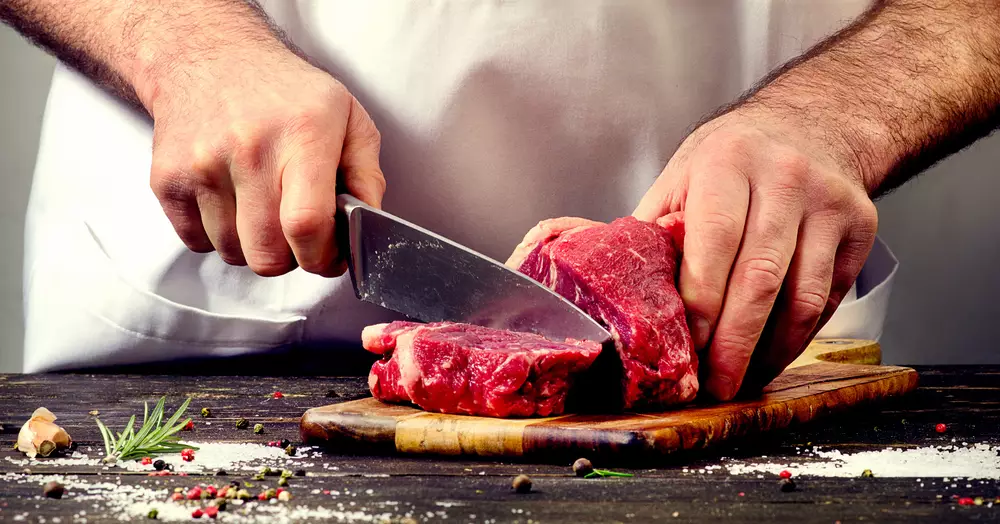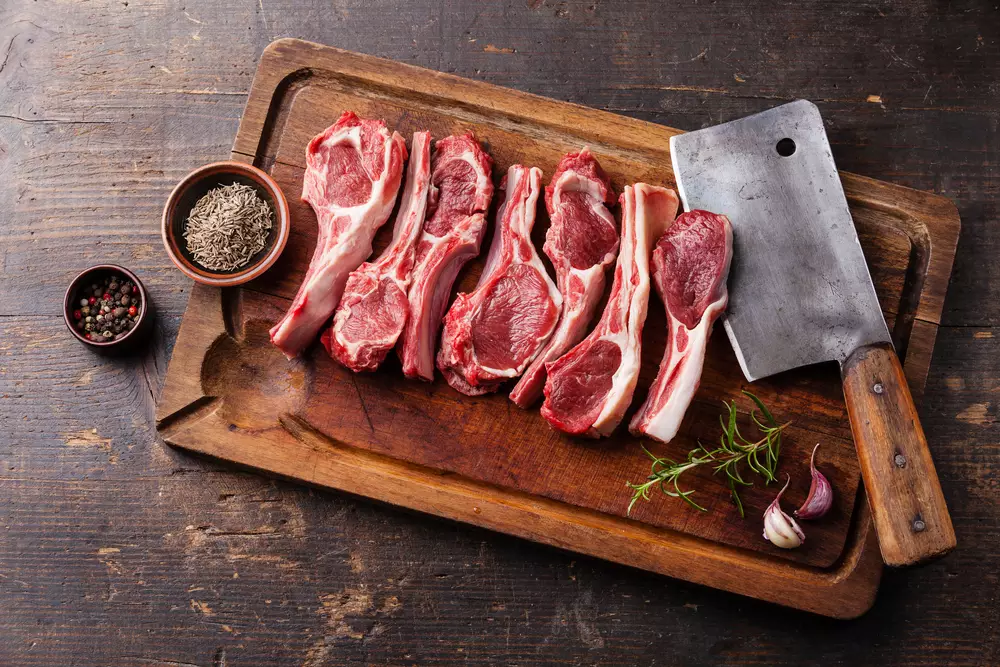When it comes to kitchen knives, two types that often get compared are butcher knives and chef knives. While both are essential tools for the home or professional kitchens, they have different shapes, sizes, and uses.
Butcher knives are designed for heavy-duty tasks such as breaking down large cuts of meat, while chef knives are more versatile and can handle a range of cutting, slicing, and chopping tasks.
Understanding the differences between these two knives can help you to choose the right tool for your specific needs in the kitchen. Butcher knives typically have a long and broad blade that tapers to a sharp point. This design is ideal for slicing through meat, cutting through bones, and separating joints. They are also heavier than chef knives, which makes them more suitable for tasks that require a bit of force.
Besides, chef knives have shorter, narrower blade that is curved to facilitate rocking motions. This design allows for precision cutting and makes them great for tasks like chopping vegetables, mincing herbs, and slicing delicate meats.
While both knives are designed to make tasks in the kitchen easier, it’s important to consider what you will be using them for before making a purchase. If you frequently work with large cuts of meat, a butcher knife will be the better choice. However, if you’re looking for a knife that can handle a range of tasks and is suitable for everyday use, a chef knife may be more practical.

Understanding the differences between Butcher Knives Vs Chef Knives
Butcher Knife: The Meat Master
Butcher knives have been an essential tool for centuries, used by butchers and cooks alike to cut through meat with precision and ease. While there are many types of knives used in the kitchen, a good butcher knife is crucial for anyone who wants to prepare and cook meat properly.
With its long, sturdy blade and razor-sharp edge, a butcher knife can make quick work of even the toughest cuts of meat, helping to create delicious & succulent dishes that are sure to impress.
Chef Knife: The Kitchen Workhorse
A chef knife is often considered the most versatile tool in the kitchen, capable of performing a wide variety of tasks with ease. From slicing and dicing to chopping and mincing, a good chef knife can make food preparation a blow.
With its sharp, tapered blade and comfortable handle, a chef knife can be used for everything from trimming meat to chopping vegetables and herbs. Whether you’re a professional chef or an amateur cook, a high-quality chef knife is an essential part of your culinary arsenal.
Differences Between Butcher Knife and Chef Knife
Blade Shape
While both the butcher knife and chef knife are essential tools in the kitchen, they differ in their blade shapes, which can impact their intended uses and cutting abilities. The butcher knife typically has a long, straight blade that is designed for cutting through large cuts of meat with ease. The blade is usually thicker and heavier than a chef knife, allowing it to apply more force when needed.
In contrast, the chef knife typically has a curved, tapered blade that is designed for a wide range of tasks, such as slicing, dicing, and chopping. The blade is thinner and lighter than a butcher knife, allowing for greater precision and control when cutting through smaller ingredients. Additionally, the pointed tip of a chef knife allows for more delicate work, such as trimming and carving.
Weight
The weight of a knife is an important factor to consider when choosing between a butcher knife and a chef knife. Butcher knives are generally heavier than chef knives, which allows them to handle the tough work of cutting through dense cuts of meat. The added weight of a butcher knife gives it the force necessary to slice through meat with ease, and it can also help prevent fatigue when cutting through large quantities of meat.
In contrast, chef knives are typically lighter and more balanced, allowing for greater control and precision when cutting through smaller ingredients. The lighter weight of a chef knife makes it easier to maneuver and allows for more delicate work, such as slicing through herbs or filleting fish.
Ultimately, the choice between a butcher knife and a chef knife comes down to the specific tasks you’ll be performing in the kitchen, as well as your personal preference for weight and balance.
Size
The size of a knife is an important factor to consider when choosing between a butcher knife and a chef knife. Butcher knives are typically larger than chef knives, with blades that range from 6 to 14 inches in length. The longer blade of a butcher knife allows it to handle larger cuts of meat and makes it easier to achieve long, smooth cuts.
In contrast, chef knives are usually smaller, with blades that range from 6 to 10 inches in length. The shorter blade of a chef’s knife allows for greater control and precision when cutting through smaller ingredients, such as fruits, vegetables, and herbs.
Additionally, the smaller size of a chef knife makes it easier to handle and maneuver in tight spaces. Ultimately, the choice between a butcher knife and a chef knife comes down to the specific tasks you’ll be performing in the kitchen, as well as your personal preference for size and blade length.

Advantages & Disadvantages Between Butcher Knife Vs Chef Knife
Butcher Knives
Advantages of Butcher Knives:
- Ideal for heavy-duty cutting tasks: Butcher knives are designed to handle large, tough cuts of meat, making them ideal for heavy-duty cutting tasks that require a lot of force.
- Long, sturdy blade: The long, straight blade of a butcher knife allows for clean, smooth cuts through meat, while the thickness of the blade helps to prevent it from bending or breaking.
- Easy to sharpen: Because of their thick blades, butcher knives are relatively easy to sharpen, and can maintain their edge for a long time with proper care.
- Versatile: While butcher knives are primarily used for cutting meat, they can also be used for a variety of other tasks, such as chopping vegetables or crushing garlic.
Disadvantages of Butcher Knives:
- Limited use: Butcher knives are primarily designed for cutting meat, which means that they may not be as versatile as other types of knives in the kitchen.
- Bulky and heavy: The weight and size of a butcher knife can make it difficult to handle, especially for those with smaller hands.
- Storage: The size and shape of a butcher knife can make it difficult to store in a standard knife block, requiring separate storage or special care to avoid damage to other knives.
Overall, butcher knives are a great choice for anyone who regularly works with large cuts of meat or needs a heavy-duty cutting tool. However, they may not be the best choice for those who need a more versatile knife or have limited storage space.
Chef Knives
Advantages of Chef Knives:
- Versatile: Chef knives are designed for a wide range of tasks, including chopping, slicing, and dicing, making them one of the most versatile knives in the kitchen.
- Comfortable to use: The ergonomic design of chef knives makes them comfortable to use, even for extended periods of time.
- Lightweight: Chef knives are usually lighter than other types of knives, making them easier to handle and maneuver when working with smaller ingredients.
- Easy to store: Chef knives are often designed to fit into a standard knife block, making them easy to store and access in the kitchen.
Disadvantages of Chef Knives:
- Not ideal for heavy-duty tasks: While chef knives can handle a wide range of tasks, they may not be the best choice for heavy-duty cutting tasks, such as breaking down large cuts of meat.
- Requires frequent sharpening: The thin blade of a chef knife requires frequent sharpening to maintain its edge, which can be time-consuming.
- May not have a pointed tip: Some chef knives are designed with a rounded tip, which can make it difficult to perform certain tasks, such as trimming meat or scoring bread
Select The Right Knife for Your Kitchen
Choosing the right knife for your kitchen can make all the difference in your cooking experience. Here are some tips to help you select the right knife:
- Consider your needs: Before selecting a knife, consider what types of tasks you’ll be using it for. If you primarily cook meat, a butcher knife may be the best choice, while a chef knife is more versatile and can handle a wide range of tasks.
- Look for quality: A high-quality knife will not only last longer, but it will also make your cooking experience easier and more enjoyable. Look for knives made with high-quality materials, such as carbon or stainless steel, and comfortable, ergonomic handles.
- Test the weight and balance: A knife that feels comfortable and well-balanced in your hand will be easier to use and reduce fatigue. Try holding and testing different knives to find one that feels right for you.
- Consider maintenance: Some knives require more maintenance than others, such as frequent sharpening or special storage. Consider how much time and effort you’re willing to put into maintaining your knife before making a purchase.
- Don’t be afraid to invest: A high-quality knife can be a significant investment, but it’s worth it for the long-term benefits of your cooking experience. A well-made knife will last for years, making it a worthwhile investment for any serious home cook or professional chef.
Conclusion
While both the butcher knife and chef knife are essential tools for any kitchen, they each serve a different purpose. The butcher knife is designed for heavy-duty tasks such as breaking down large cuts of meat, while the chef knife is more versatile and suited for a variety of tasks such as slicing, dicing, and chopping vegetables and spices.
Eventually, the decision of which knife to use will depend on the specific task at hand. Whether you’re a professional chef or a home chef, investing in high-quality knives and knowing when to use each one can greatly improve your cooking experience and the quality of your dishes.
